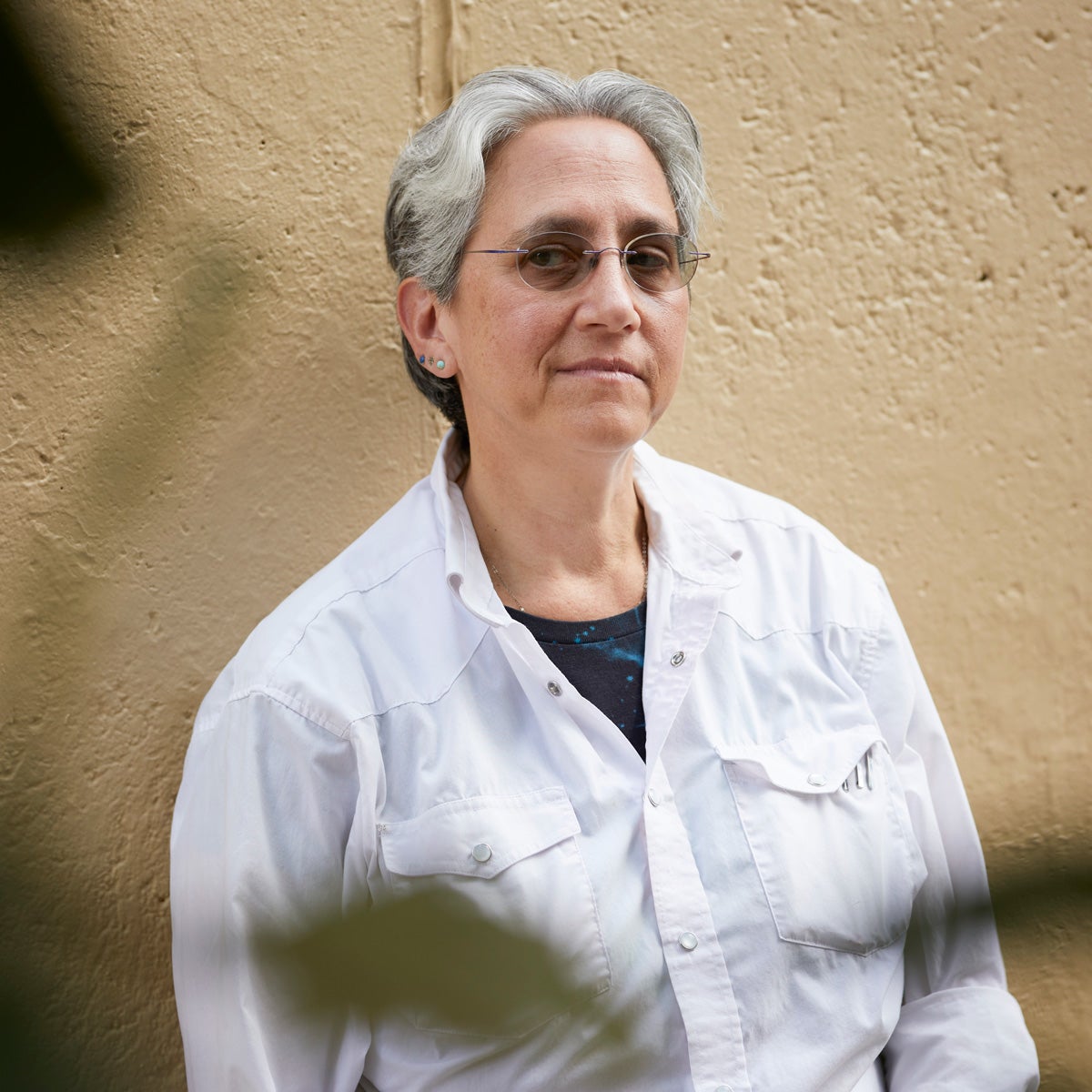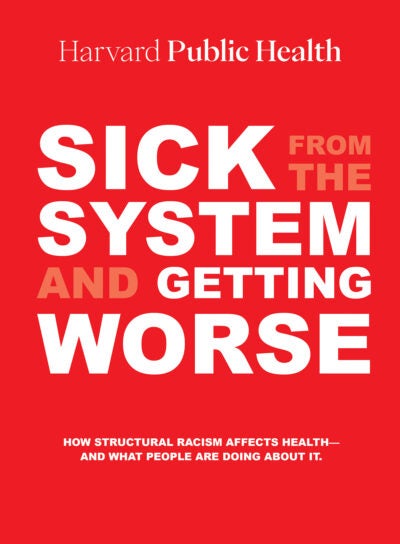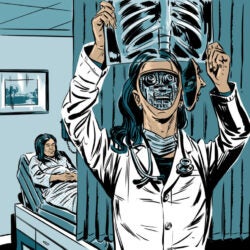
Feature
Revisiting the ‘Unequal Treatment’ report, 20 years later
It was a never a secret. For decades, doctors and public health officials knew that racial and ethnic minorities experienced worse health outcomes than white Americans in nearly every category of disease and ailment—including heart disease, diabetes, HIV, and infant mortality. Until 20 years ago, however, they were split on the impact that health care quality had on those disparities.
In the 1990s, research increasingly showed that “if two people arrived in the emergency room, and all things were equal except for the color of their skin, there were differences in the quality of care that patients received,” says Joseph Betancourt, MPH ’98, senior vice president, equity and community health, at Massachusetts General Hospital. But some argued race had nothing to do with it, except as a stand-in for other factors, such as poverty or education, that disproportionately affect minorities. Finally, the quasi-governmental Institute of Medicine commissioned a blue-ribbon committee of doctors, nurses, and health officials to settle the matter, specifically examining why those disparities existed, and what could be done to address them.
Among those who helped push for the report was the late Jack Geiger, SM ’60, professor emeritus at City College of New York, who would go on to write one of its chapters. He also recruited David Williams—now Florence Sprague Norman and Laura Smart Norman Professor of Public Health and Chair, Department of Social and Behavioral Sciences, at the Harvard Chan School, then at the University of Michigan—to serve on the committee. In the early 1990s, Williams had developed the Everyday Discrimination Scale, a tool used in studying the ways race affected how people were treated on a day-to-day basis. Other Harvard Chan School faculty who contributed to the report were the late W. Michael Byrd and his wife Linda Clayton, both instructors in public health practice. Byrd served on the committee and he and Clayton co-wrote a chapter.
The committee began systematically examining the evidence, looking at more than 900 peer-reviewed papers that controlled for poverty, education, and other social determinants of health to focus specifically on the impact of race in the quality of health care, concluding in no uncertain terms that it played a role in the receipt of inferior care that could lead to poorer outcomes. “I still remember one of the early meetings of the committee: When Jack Geiger presented his review of the literature there was a hush in the room. You could have heard a pin drop,” Williams says. “The evidence was overwhelming that there was a problem.”
The landmark 2002 report that the committee produced, “Unequal Treatment: Confronting Racial and Ethnic Disparities in Health Care”, made the nightly news on all of the major networks on the day it appeared. It reverberated through the health care establishment, detailing unequivocally the harmful disparities minorities experienced in the health system. “The sources of these disparities are complex, are rooted in historic and contemporary inequities, and involve many participants at several levels, including health systems, their administrative and bureaucratic processes, utilization managers, health care professionals, and patients,” the report stated in its abstract. No longer could access to treatment be explained away as a function of economic circumstances.

“I still remember one of the early meetings of the committee: When Jack Geiger presented his review of the literature there was a hush in the room. You could have heard a pin drop. The evidence was overwhelming that there was a problem.”
david williams
The report attributed lower care received by minorities to multiple causes such as communication barriers. In addition, minorities were less likely to trust doctors and follow their care, perhaps as a result of past poor treatment. Yet these factors only had a small impact on care; the report found that the biggest impact was likely due to stereotyping and prejudice by caregivers, even if unconscious, that consistently led them to misdiagnose and undertreat minority patients.
The report’s 21 recommendations fell into three broad categories: increasing the proportion of minority health professionals; improving education for caregivers in the biases that affected treatment, and education for patients in how to better navigate the system; and implementing monitoring and evaluation among health plans and medical institutions to assess progress toward eliminating health disparities. “We knew if we were going to make a transition from research to practice, then we needed to encourage health care systems to not only collect the data, but also manage their performance,” Betancourt says.
While the report noted the persistence of racism in society, it did not apply the word to the medical profession, instead using words such as “stereotyping” and “bias.” This language reflected existing science, Williams says, noting that at the time there were no studies directly linking implicit bias in a provider to clinical decision-making.
Even so, the report’s greatest legacy has been in framing the problem and catalyzing research to better understand the impact of the problem, which has been more and more explicitly called out as racism in the past 20 years. “It opened up the door to the design and implementation of new medical services,” says Nancy Krieger, professor of social epidemiology at the Harvard Chan School. “If you want to have good physicians practicing good medicine, you need to understand how systemic racism is harming the knowledge they have and potentially the practices they do, and how they can change that with the goal of doing better by their patients.”
“It gave us a way to start having the conversation,” says Tamarra James-Todd, Mark and Catherine Winkler Associate Professor of Environmental Reproductive Epidemiology, whose research has highlighted environmental racism and its health consequences, from the toxic legacy of historically redlined neighborhoods to the increased health risks from chemicals found in beauty products marketed to Black women. “It brought us to a place of common ground to have those discussions so interventions could happen.”
In the intervening two decades, the gap between white people and racial and ethnic minorities has remained frustratingly persistent, with little concrete progress to show for the efforts that have been made to close it.
The health system has made the most progress on improving monitoring and performance measurement on racial metrics, especially in the first decade after the report. Betancourt helped lead the way on that effort, creating the Disparities Solutions Center at Massachusetts General Hospital in 2005 to serve two purposes: provide internal guidance to identify and address disparities, and create tools to assure advancement of this work on a national level. To date, its Disparities Leadership Program has trained health care leaders at more than 300 organizations, including 200 hospitals and more than 50 health plans across 35 states. Many health care systems in the United States now do at least some form of implicit bias training for their staff, says Williams, and many medical schools also include bias training for medical students.

“[Unequal Treatment] brought us to a place of common ground to have discussions so interventions could happen.”
Tamarra james-todd
Despite such investments, Betancourt says efforts to address racial disparities lost momentum over the next decade due to the logistical challenges and competing demands of health care reform. While organizations piloted a range of interventions, including navigators, community health workers, and health care coaches, these programs often fell victim to the whims of individual grants. Betancourt says, “There is a large graveyard of great interventions that could not be sustained because they were funded by foundations or grants or contracts.”
Clearly the amount of research on issues of racial disparities in public health, at least, has increased. And over time, researchers also became more comfortable calling this bias what it is: systemic racism in the health care system. In a recent American Journal of Preventive Medicine commentary, Krieger looked back over the last 30 years and found that in 1991 the term “racism” yielded less than 300 articles published in scholarly health journals; now that number is almost 8,400. Of those, some 3,400 have been published since 2019, showing the huge increase in interest following the Black Lives Matter protests in the wake of George Floyd’s murder, as well as the racial disparities in COVID-19 outcomes.
In addition, the National Institutes of Health committed itself in February 2021 to eliminating structural racism in health practice; in April 2021, the CDC went so far as to declare racism a public health threat—a potentially promising sign for government funding. “It gives license for more people to start to do work in these areas,” Krieger says. “You’re watching for more money shifting into research and programs to do more implementation that has an explicit racial equity lens.” Also promising, she says, are efforts by medical school curricula to seriously address these matters.
One barrier to progress in Williams’ mind is the lack of universal health care that would ensure equal access across racial and income groups. Beyond that, however, bias in treatment continues—even in the most prestigious medical centers. One study of heart patients at Boston’s Brigham and Women’s Hospital, for example, found Black and Latino patients were more likely to be admitted to general care, while white patients were admitted to cardiology service. After 30 days, the minority patients were more likely to be readmitted, a proxy for quality of care. “It’s just a striking example of a study that suggests that these problems still persist,” says Williams.
While the “Unequal Treatment” report spurred design and implementation of anti-racism work in medical treatment, says Krieger, it has been less effective in addressing how racism impacts the economic and environmental circumstances in which people live and work—part of the reason the racial health gap has remained so persistent. It’s not enough to recommend people get more exercise and eat more nutritious food, she says, if they don’t have adequate green space in their neighborhood or accessible grocery stores with affordable healthy foods. Similarly, when looking at why people in Black and Latino communities were less likely to be vaccinated in the early months of the pandemic, health officials tended to look at individual choices rather than systemic issues such as availability of transportation or paid sick-leave to recover from the vaccine’s effects. “There was a lot of victim-blaming,” says Krieger, “and not enough focus on access.”
Krieger has been instrumental in spearheading better ways to track health inequities, coming up with the first measures for racialized economic segregation starting in 2014. To do this, she extended use of the Index of Concentration at the Extremes (ICE), developed by sociologist Douglas Massey to measure economic polarization between groups in a certain area. Bringing racism into the picture, the new metric she devised measured spatial polarization between high income white non-Hispanic households vs. low-income households of color. She then used these ICE measures across Massachusetts to demonstrate that racialized economic segregation had the strongest associations with diverse health outcomes including cancer and infant mortality. “It allows you to have a discussion of racism and class relations in the same sentence,” Krieger says. “You can’t understand the system of racial injustice without understanding how it ties to economic injustice. It’s not either/or, it’s both/and.”

“You can’t understand the system of racial injustice without understanding how it ties to economic injustice. It’s not either/or, it’s both/and.”
nancy krieger
In May 2020, Krieger and colleagues Jarvis Chen and Pamela Waterman used the framework to examine social inequities in the pandemic mortality surge in Massachusetts. Working with colleagues at the Boston Globe, they found a higher rate of excess deaths correlated not only with a higher percentage of racial and ethnic minorities, but also with poverty, household crowding, economic segregation and, most strongly, racialized economic segregation. The information served as a national model to monitor the pandemic’s disparate impact.
Over the past two years, analyses such as these have raised more awareness of the complicated interplay between racial and economic disparities to better examine the overall effects of structural racism on health. James-Todd has seen greater urgency, as well as a broader range of voices included in the conversation around health equity. “There have been more seats added to the table for people doing the work, which widens our understanding” she says.
Tackling the drivers of inequity—most of which exist outside of the health care system—will take a much more comprehensive approach to addressing racial disparities in public health than the measures recommended by Unequal Treatment. James-Todd says, “We need to get into the habit of looking beyond the deficits within certain communities and seeing their assets. Researchers can work collaboratively with communities to co-develop and amplify their resources through interventions to help mitigate disparities, so that our work becomes more solution-oriented.”
Playing off the need to develop “herd immunity” to COVID, Williams urged the development of a “herd immunity” to bias and racism in society in a recent paper he co-wrote with Johns Hopkins’ Lisa Cooper that appeared in the Journal of American Medicine. “There are reasons to be disturbed by what’s happening in society,” Williams says. “But also there are reasons to be optimistic because of the greater awareness and greater commitment of so many social institutions.”



